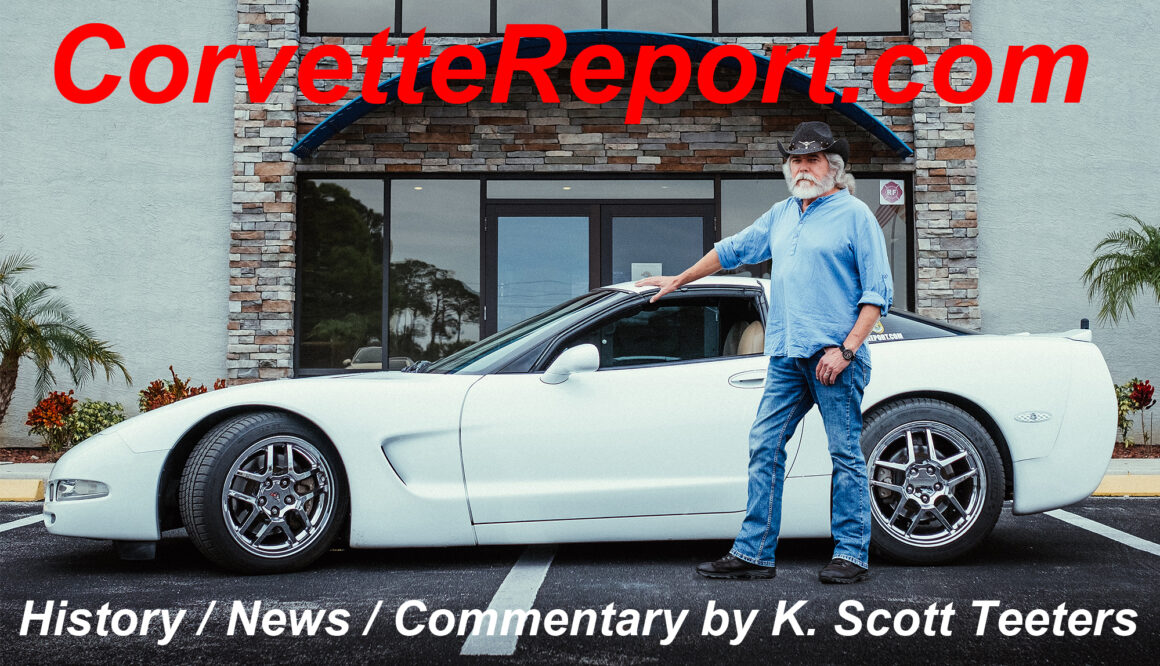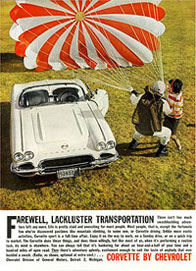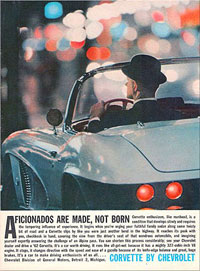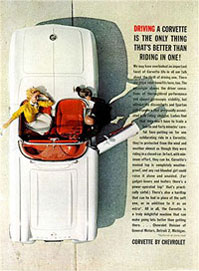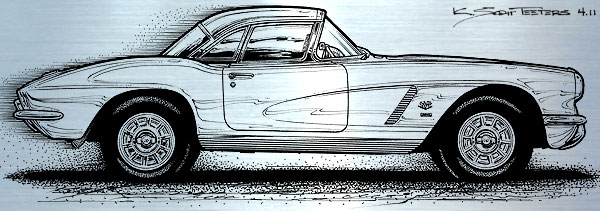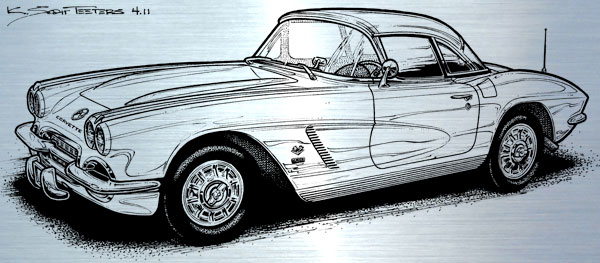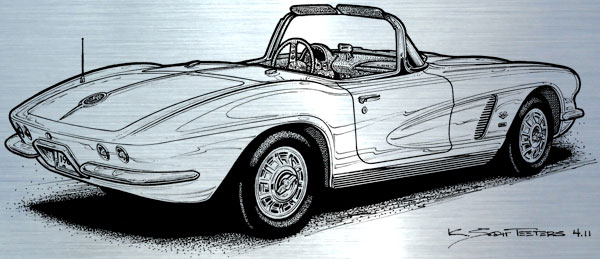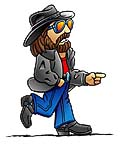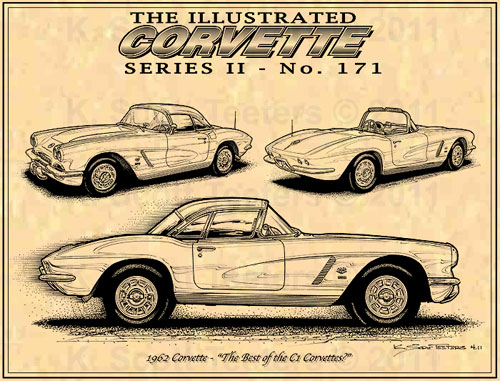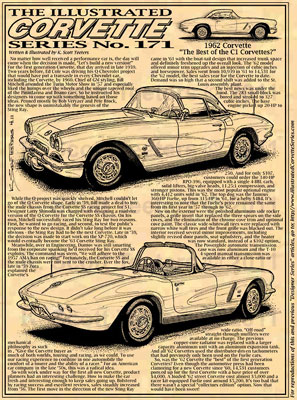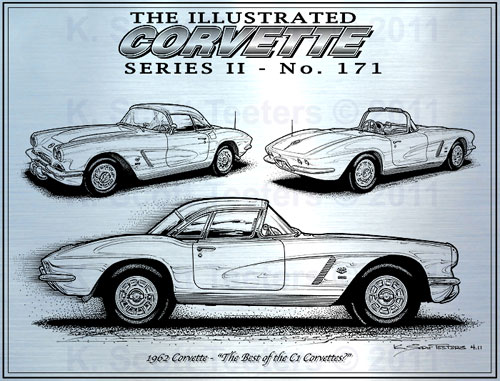The straight-axle Fuelie was tough enough to win it’s class at Le Mans in ‘61. Was the last of the C1 the “best”? Let’s have a look-see!
Click the images to see much larger images of these classic Corvette ads.
No matter how well received a performance car is, the day will come when the decision is made, “Let’s build a new version!” For the first generation Corvette, that day arrived in late 1959. Two years before, Ed Cole was driving his Q-Chevrolet project that would have put a transaxle in every Chevrolet car, including the Corvette, by 1960. Chief of GM styling, Bill Mitchell attended the Turin Motor Show in ‘57 and especially liked the humps over the wheels and the unique tapered roof of the Pininfarina and Boano cars. So he instructed his designers to come up with something based on those ideas. Penned mostly by Bob Veryzer and Pete Brock, the new shape is unmistakably the genesis of the Sting Ray.
While the Q-project was quickly shelved, Mitchell couldn’t let go of the Q-Corvette shape. Early in ‘59, Bill made a deal to buy the mule chassis from the Corvette SS racing project for $1. Designer Larry Shinoda was charged with designing a roadster version of the Q-Corvette for the Corvette SS chassis. On his own, Mitchell successfully raced his Sting Ray for two reasons. First, he wanted to go racing, and second, to test the public’s response to the new design. It didn’t take long before it was obvious – the Sting Ray had to be the next Corvette. Late in ‘59, the decision was made to start work on the XP-720, which would eventually become the ‘63 Corvette Sting Ray.
Meanwhile, over in Engineering, Duntov was still smarting from the corporate spanking he’d received for his Corvette SS exploits. The command was stern, “We will adhere to the 1957 AMA ban on racing!” Fortunately, the Corvette SS and the mule chassis were not sent to the crusher. Ever the fox, late in ‘59 Zora explained the Corvette’s mechanical philosophy as such in , “Give the Corvette buyer as much of both worlds, touring and racing, as we could. To use our racing experience to combine in one automobile the comfort of a tourer and the ability of a racer.” For an American car company in the late ‘50s, this was a radical idea.
So with work under way for the first all-new Corvette, product planners had an interesting challenge. How to make the car fresh and interesting enough to keep sales going up. Bolstered by racing success and excellent reviews, sales steadily increased from ‘56. The first move in the direction of the new Sting Ray came in ‘61 with the boat-tail design that increased trunk space and definitely freshened up the overall look. The ‘62 model offered minor trim upgrades and an injection of cubic-inches and horsepower. Sales went from 10,939 in ‘61 to 14,531 for the ‘62 model, the best sales year for the Corvette to date. Demand was so high that a second shift was added to the St. Louis assembly plant.
The best news was under the hood. The 283 small-block was bored and stroked to 327 cubic-inches. The base engine picked up 20-HP to 250. And for only $107, customers could order the 340-HP RPO-396, equipped with a single 4-BBL carb, solid-lifters, big-valve heads, 11.25:1 compression, and stronger pistons. This was the most popular optional engine with 4,412 units sold in ‘62. The top dog was the famous 360-HP Fuelie, up from 315-HP in ‘61, for a hefty $484. It’s interesting to note that the Fuelie’s price remained the same from its first year in ‘57 through to ‘62.
New on the exterior were the polished aluminum side rocker panels, a grille insert that replaced the three spears on the side coves, and the elimination of the chrome cove trim and optional cove paint. The classic wide-whitewall tires were replaced with narrow white wall tires and the front grille was blacked out. The interior received several minor improvements, including slightly revised door panels, seat upholstery, and the heater was now standard, instead of a $102 option,. The Powerglide automatic transmission case was now aluminum and the T-10 4-speed manual transmission was available in either a close-ratio or wide-ratio. “Off-road” straight-through mufflers were available at no charge. The previous copper-core radiator was replaced with a larger capacity aluminum unit with an aluminum expansion tank. And all ‘62 Corvettes used the distributer-driven tachometers that had previously only been used on the Fuelie cars.
So, was the ‘62 Corvette the “best” of the first generation Corvettes? Even though the automotive press had been clamoring for a new Corvette since ‘60, 14,531 customers ponyed up for the first Corvette with a base price of over $4,000. A loaded ‘62 street Corvette cost almost $5,000 and a racer kit-equipped Fuelie cost around $5,200. It’s too bad that there wasn’t a special “collectors edition” option. Now that would have been sweet!
Scott
PS – Be sure to check out the 1962 Corvette Sales brochure slide show at the bottom of this post.
Parchment and Laser-Etched prints of Illustrated Corvette Series No 171 are available HERE. Or, click the below images to go to our www.IllustratedCorvetteSeries.com website.
Enjoy the slide show of the 1962 Corvette sales brochure!
[nggallery id=14]
